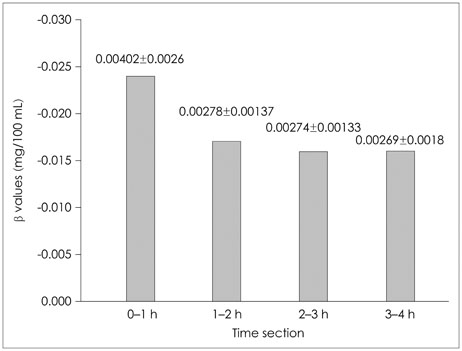J Korean Neuropsychiatr Assoc.
2015 Nov;54(4):427-434. 10.4306/jknpa.2015.54.4.427.
Elimination Rate and Pharmacokinetics of Alcohol in Korean Healthy Male Adults
- Affiliations
-
- 1Department of Psychiatry, School of Medicine, Konkuk University, Chungju Hospital, Chungju, Korea. sjs52632@hanmail.net
- 2Department of Mechanical Engineering, Korea National University of Transportation, Chungju, Korea.
- KMID: 2149324
- DOI: http://doi.org/10.4306/jknpa.2015.54.4.427
Abstract
OBJECTIVES
The objective of this study is to identify alcohol pharmacokinetics and to investigate the correlations between various factors for alcohol metabolism of healthy Korean males.
METHODS
The 101 recruited volunteers were randomized into two groups as one group provided 0.35 mg/mL/kg and 0.7 mg/mL/kg, the other. Blood alcohol concentration was measured and analyzed in enzymatic methods eight times from drinking point.
RESULTS
Alcohol elimination rate (beta) was found to be -0.0083%/h for low dose group and -0.0157%/h for the high dose group. The results indicate discrepancy in the legal criteria of alcohol elimination rate (-0.008%/h). The measured alcohol pharmacokinetic properties were following : mean time to reach maximum alcohol concentration in blood was 30 minutes, absorption rate was 0.0197%, maximum alcohol concentration in blood was 0.4930%, and Area under the curve was 59.25. Also, alcohol elimination was not affected by age, smoking, total body water, drinking capacity, body mass index, blood cholesterol, body fat, and body fat ratio.
CONCLUSION
These results suggest that legal limitation could be adjusted in Korean males. Also the research should be extended including female and senior citizens for statistical significance of the research. These findings have contributed to our knowledge of the alcohol pharmacokinetics in Korean male.
MeSH Terms
Figure
Cited by 1 articles
-
Alcohol Consumption,
Aldehyde Dehydrogenase 2 Gene Polymorphisms, and Cardiovascular Health in Korea
Min-Jeong Shin, Yoonsu Cho, George Davey Smith
Yonsei Med J. 2017;58(4):689-696. doi: 10.3349/ymj.2017.58.4.689.
Reference
-
1. Medscape.com [homepage on the Internet]. Ethanol level. New York: Medscape from WebMD;updated 2014 Feb 4. cited 2014 Nov 9. Available from: http://emedicine.medscape.com/article/2090019-overview.2. Lee WY. Blood alcohol concentration and blood-brain partition ratio by drinking conditions [dissertation]. Seoul: Dongguk University;2007.3. Dubowski KM. Absorption, distribution and elimination of alcohol: highway safety aspects. J Stud Alcohol Suppl. 1985; 10:98–108.
Article4. Hamsnetwork.org [homepage on Internet]. Metabolism of Ethyl alcohol in the body. New York: The HAMS Harm reduction network, Inc.;c2007-2008. updated 2013 Mar 8. cited 2014. Available from: http://www.hamsnetwork.org/boggan.5. Lands WE. A review of alcohol clearance in humans. Alcohol. 1998; 15:147–160.
Article6. Vonwartburg JP, Bethune JL, Vallee BL. Human liver--alcohol dehudrogenase. Kinetic and physicochemical proprtties. Biochemistry. 1964; 3:1775–1782.7. Cronholm T, Jones AW, Skagerberg S. Mechanism and regulation of ethanol elimination in humans: intermolecular hydrogen transfer and oxidoreduction in vivo. Alcohol Clin Exp Res. 1988; 12:683–686.
Article8. Wilkinson PK, Sedman AJ, Sakmar E, Kay DR, Wagner JG. Pharmacokinetics of ethanol after oral administration in the fasting state. J Pharmacokinet Biopharm. 1977; 5:207–224.
Article9. Hong SW. A study on the reproducibility of blood alcohol concentration-time profile of an individual. Anal Sci Technol. 2013; 26:199–204.
Article10. Gubala W, Piekoszewski W. Widmark's equation versus pharmacokinetic modeling in back calculation of alcohol concentration. Probl Forensic Sci. 2002; 50:35–43.11. Kim DW, Lee WY, An BJ, Kim IS, Chung YH, Min JS, et al. A study of blood and breath Alcohol Concentration partition ratio in Korean drinking. Korean J Forensic Sci. 2007; 8:38–65.12. Taylor JL, Dolhert N, Friedman L, Mumenthaler M, Yesavage JA. Alcohol elimination and simulator performance of male and female aviators: a preliminary report. Aviat Space Environ Med. 1996; 67:407–413.13. Kats.go.kr [homepage on Internet]. Available from: http://sizekorea.kats.go.kr/03_report/1st.asp.14. Simpson G. Uncertain validity of Widmark calculations for estimating blood alcohol concentrations. J Anal Toxicol. 1989; 13:374.
Article15. Widmark EMP. Principles and applications of medicolegal alcohol determination. Davis: Biomedical Publications;1981.16. Levitt DG. PKQuest: measurement of intestinal absorption and first pass metabolism-application to human ethanol pharmacokinetics. BMC Clin Pharmacol. 2002; 2:4.17. Ramchandani VA, Kwo PY, Li TK. Effect of food and food composition on alcohol elimination rates in healthy men and women. J Clin Pharmacol. 2001; 41:1345–1350.
Article18. Lee JS, Kim YS. Baking characteristics of taurine supplemented bread and cookies and its effect on blood alcohol concentrations. Korean J Food Nutr. 2009; 22:479–484.19. Lee WY, Ko MS. Analysis about the reliability of sobriety testing (focused on the Blood-Breath Ratios). J Korean Soc Transp. 2008; 26:49–60.20. Gullberg RG. Estimating the uncertainty associated with Widmark's equation as commonly applied in forensic toxicology. Forensic Sci Int. 2007; 172:33–39.
Article
- Full Text Links
- Actions
-
Cited
- CITED
-
- Close
- Share
- Similar articles
-
- A Detailed Analysis of Alcohol Pharmacokinetics in Healthy Korean Men
- Influence of Oxygen to Population Pharmacokinetics/Pharmacodynamics of Alcohol in Healthy Volunteers
- Understanding the pharmacokinetics of prodrug and metabolite
- Pharmacokinetics and pharmacodynamics of drugs for sedation
- Pharmacokinetics and dosage regimen of ceftriaxone in E. coli lipopolysaccharide induced fever in buffalo calves



